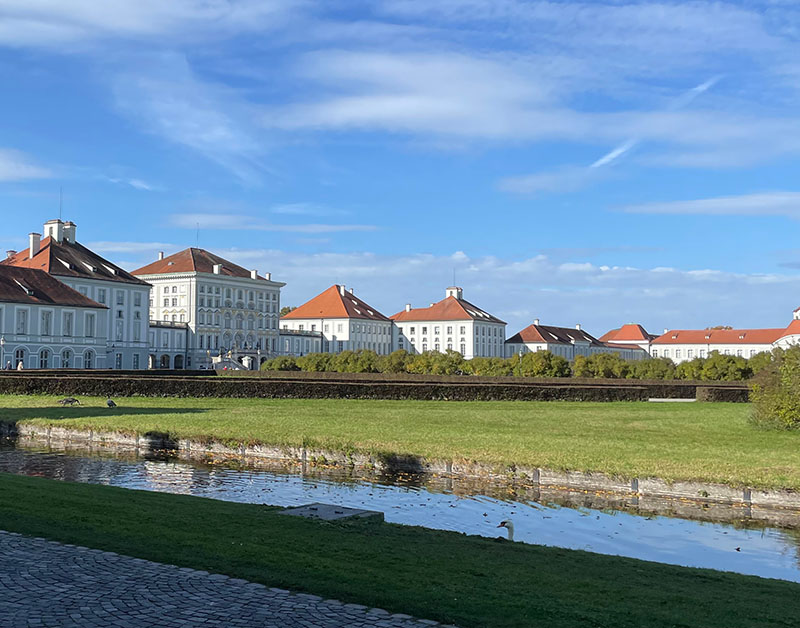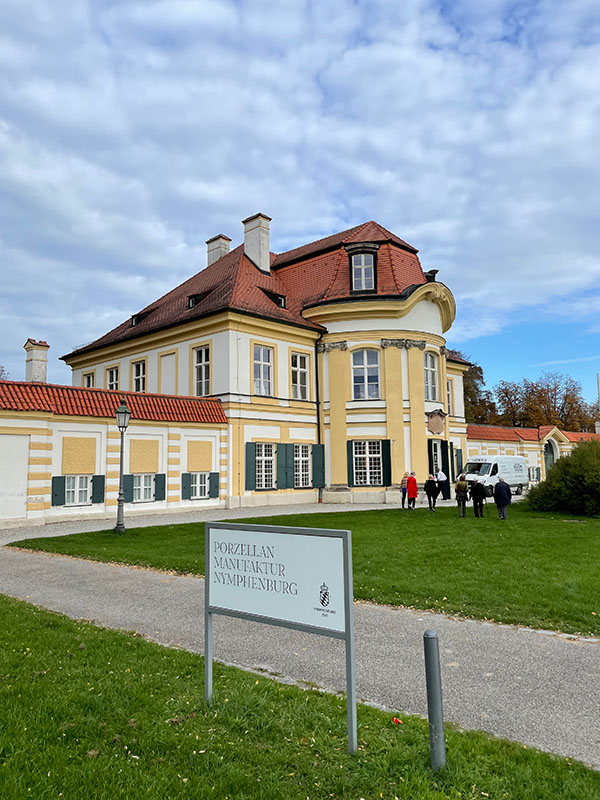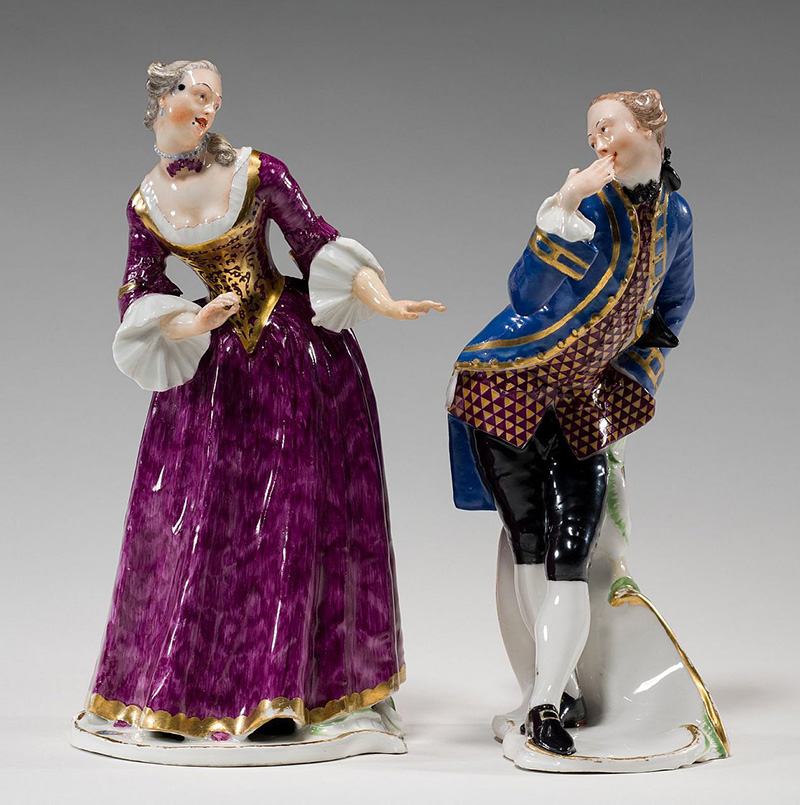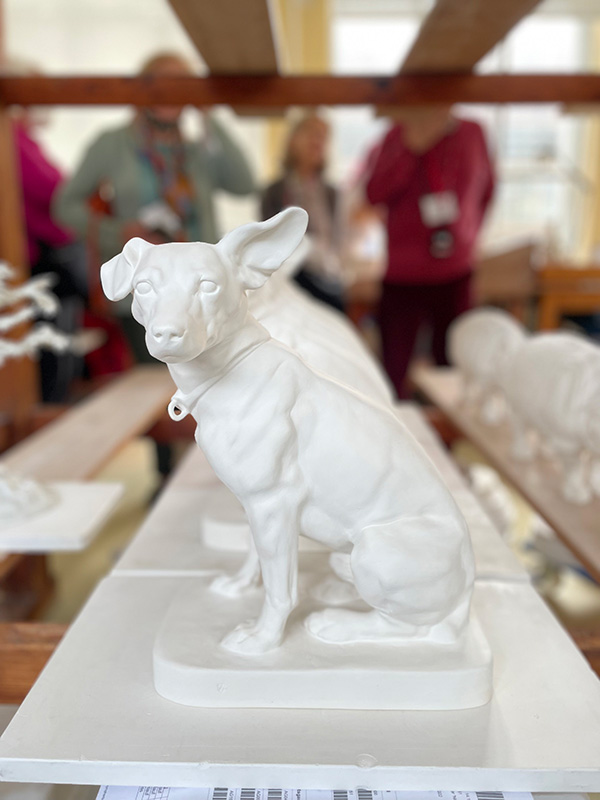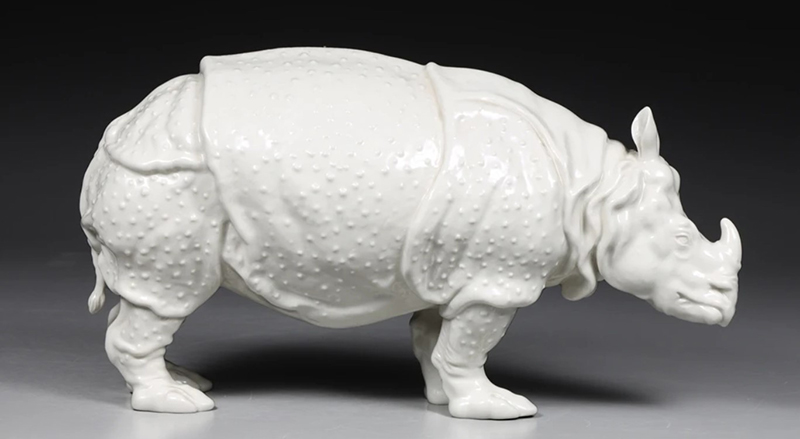Centuries of Fortitude and Fantasy: Munich’s Nymphenburg Porcelain Manufactory
by Catherine Carlisle
The Decorative Arts Trust’s visit to Germany’s southeastern state of Bavaria was replete with Baroque grandeur and Rococo drama. From official royal residenzes to countryside schlosses, our tour covered the gamut of prevailing elite tastes in architecture and decorative arts throughout the 17th, 18th, and 19th centuries.
We began in Bavaria’s capital, Munich, a medieval market town that grew steadily along with the power of the inimitable Wittelsbach dynasty. Over the family’s rule of more than 700 years, the city witnessed the construction of numerous civic, ecclesiastical, and domestic buildings across the kingdom of Bavaria, including the Residenz, the official royal palace in Munich, and Schloss Nymphenburg, a summer palace built outside the city. The Wittelsbach family stoked industry and artistry, including music, theater, and porcelain production, until the dynasty came to an end in 1918 when Ludwig III renounced his throne and title. In the following years, right-wing political fervor grew, and the city became a target of Allied bombing raids during World War II. Over forty percent of the city of Munich was destroyed, including much of the grand Residenz in the city center. Schloss Nymphenburg, on the other hand, was distant enough to avoid a direct strike and thus survives as an impressive vestige of Bavaria’s palatial history. What is even more remarkable is that within the walls of the palace park, a legendary porcelain manufactory has continued operating largely unchanged since its inception in the 18th century.
Upon arriving at Nymphenburg, one first lays eyes on the palace’s massive frontal expanse (figure 1), noted to be wider than that of Versailles. Indeed, the 18th-century expansion of Schloss Nymphenburg under Prince-Elector Maximilian III Joseph was heavily inspired by Versailles. The southern park is enveloped on both sides by a grand circle of Baroque mansions, the so-called Kavaliershäuschen, or Cavalier Houses (figure 2), built in the second half of the 18th century for courtiers. Maximilian III established Nymphenburg’s porcelain manufactory in 1747, and it has occupied one of these Cavalier Houses since 1761. With royal patronage and the skills of ceramicist Joseph Jakob Ringler and sculptor Franz Anton Bustelli, the complex production of hard paste porcelain was perfected and refined.
Bustelli’s Rococo figural work was particularly innovative and lively. His most mature designs—and those best loved by his elite patrons—included multi-figured schemes of elaborately dressed men and women trading demure glances, their curvilinear ceramic bases often bedecked with scrollwork gilding. His work leaned into the prevailing fascination with cultures farther east, and he produced a series of Chinese and Turkish figures as well as characters from the popular Italian improvisational theater Commedia dell’arte (figure 3).
Following Bustelli, many other artisans gained acclaim within the Nymphenburg Porcelain Manufactory, and its reputation among international aristocracies grew. In subsequent decades, the manufactory produced tableware, vases, accessories, and animal figures (figure 4). The figure of Clara (figure 5), a Bengalese rhinoceros and 18th-century European sensation, was modeled by Peter Anton von Verschaffelt in 1770 and remains an icon of the manufactory today. Verschaffelt, like Bustelli, created molds of successful designs so that they could be more easily replicated. Contemporary artisans are still producing wares based on these original molds.
As part of the 2022 Study Trip Abroad to Bavaria, the Decorative Arts Trust was given special access to the working manufactory at Nymphenburg. Behind one of the original Cavalier Houses, which now holds a shop of magnificent products, adjacent buildings house the workshops of the contemporary ceramicists. Between the buildings runs the Nymphenburg estate’s stream, driving a system of belts outside and inside the studios, powering mills, mixing clay, and spinning potter’s wheels, as it has since the 18th century. Upon entering the first floor of the workshop, one sees wooden racks of identical matte-white spun dishware drying in the turning shop. Dust from dried kaolin compound hugs the corners of the floor. Inside the molding studio, artisans sit at their workstations, hand-sculpting or casting every part that cannot be thrown on the potter’s wheel. From tiny pieces for delicate, intricate works—flowers to be attached to garlands, hands and facial features of Commedia dell’arte figurines—to larger forms such as the still-popular Clara, all details are precisely hand-modeled to exact specifications.
Pieces are given their final shape according to the original templates. After these meticulously sculpted works are fired, they are either left unglazed as finished pieces in bisque, immersed into a glaze bath and given a second firing, or delivered to the second floor for paint decoration before a third firing. The painting studio smells of turpentine, clove, and lavender oils, elements that are mixed with pigments to create the color palettes for finished works. The precision of the painted work is extraordinary, from delicate linework on a plate to the lifelike fur and plumage of their prized animal figures, all are executed by painters who have completed a lengthy apprenticeship, working entirely freehand, without the aid of stencils (figure 6).
Since the Nymphenburg Porcelain Manufactory’s arrival at the palace in 1761, its porcelain production has evolved to become ever-more sophisticated, resulting in pieces that are internationally acclaimed for their beauty and delicacy. The Trust’s visit to the workshop allowed a rare opportunity to witness crafts-people working in historic techniques that have been carefully preserved—where the time, training, and labor of handmade artistry is prioritized over the efficiency of machines—and in a place where the very innovators of the craft itself worked, experimented, and perfected the art of hard paste porcelain.
Catherine Carlisle is the Manager of Educational Programs at the Decorative Arts Trust.
A print version of this article was published in The Magazine of the Decorative Arts Trust, one of our most popular member benefits. Join today!

